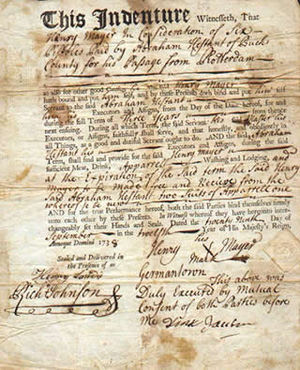
Back Treballador no abonat Catalan Smluvní služebník Czech Indentur German Nepagita servisteco EO Trabajador no abonado Spanish Engagisme French משרת חוזי HE Servitù debitoria Italian 年季奉公 Japanese 계약 하인 Korean

Indentured servitude is a form of labor in which a person is contracted to work without salary for a specific number of years. The contract, called an "indenture", may be entered voluntarily for purported eventual compensation or debt repayment, or imposed involuntarily as a judicial punishment. Many came with forged or no contract they ever saw.
Historically, for an apprenticeship, when an apprentice worked with no pay for a master tradesman to learn a trade (this was often for a fixed length of time, usually seven years or less). Apprenticeship was not the same as indentureship, although many apprentices were tricked into falling into debt and thus having to indenture themselves for years more to pay off such sums.
Many indentured servants were contracted for by American colonial Planters with the British government for so many men, women or children of various age groups. How these contracts were fulfilled wasn't important. Many quotas were met by kidnapping or duping such individuals into thinking they would have it easy in America, being promised gardens and orchards and houses, which were nonexistent, and what rewards they received at the end, little.
Like any loan, an indenture could be sold; most masters had to depend on middlemen or ships masters to recruit and transport the workers, so indentureships were commonly sold by such men to planters or others upon the ships arrival. Like slaves, their price went up or down, depending on supply and demand. When the indenture (loan) was paid off, the worker was free but not always in good health or sound of body. Sometimes they might be given a plot of land or a small sum to buy it, but the land was usually poor.
Indentured workers could marry with their master's permission. A bastard child, even if the Master's, could be sold off for up to 31 years and taken from the mother, who would receive 5 more years added to her indentureship for having it. If families came together, any members who died during the voyage must have their indentureships served by the surviving members. Furthermore, families were often separated. Those for sale could be made to strip naked, and have every part of their bodies examined like a piece of livestock.[citation needed] Once paid for, they must do whatever task the master asked. Punishments for servants were identical to those of slaves.
The original blacks sold at Jamestown were not slaves but indentured servants and many freed after a year because Virginia had no slave laws. It was only following Bacon's Rebellion that the first slave laws were enacted, and then made Masters financially responsible for any crimes or damages by the former slave once freed. It was more economical to keep them for life.